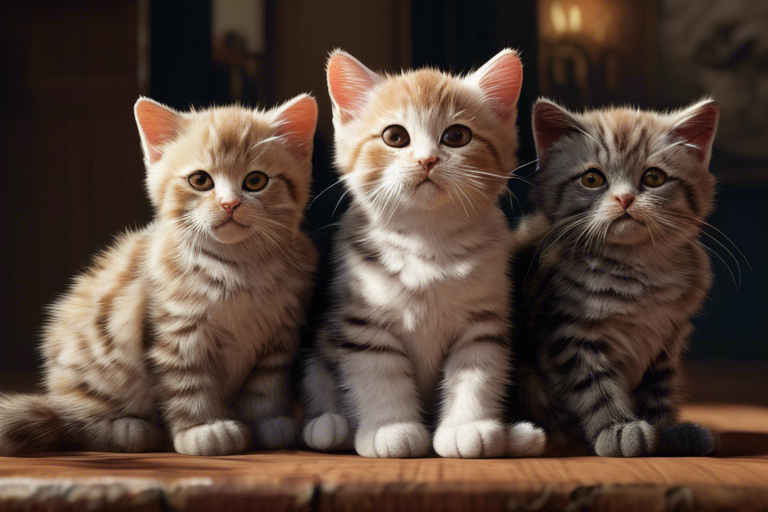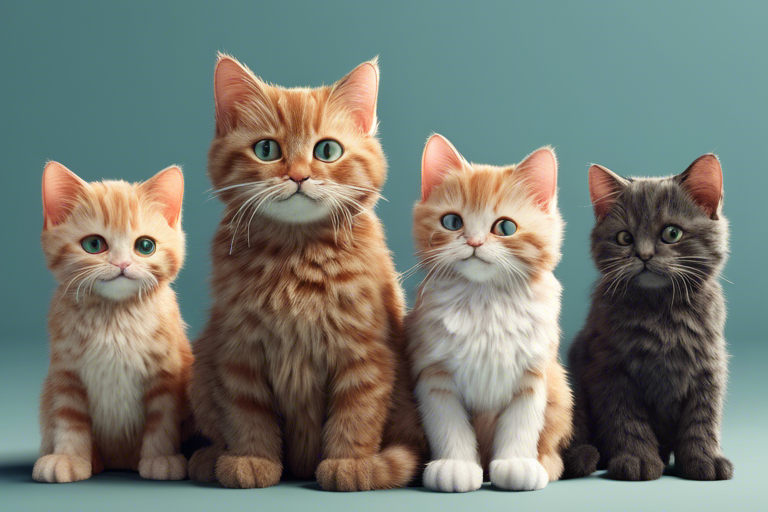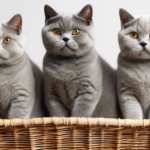Introduction
Cats have an incredible ability to communicate their emotions and intentions through body language. While their gestures may appear subtle, understanding feline body language is crucial to establishing a deeper connection with our beloved feline friends. One such gesture that cats commonly employ is nodding. In this article, we will delve into the basics of feline body language, explore the science behind why cats nod, examine the different types of nods and their meanings, and provide practical advice on interpreting and responding to our cats’ signals.
The Basics of Feline Body Language
To interpret our cats’ nods effectively, it is essential to grasp the fundamentals of feline body language. Feline body language encompasses postures, tail positions, ear positions, vocalizations, and facial expressions. Each of these signals forms an integral part of the feline communication system and can vary based on the cat’s intentions. By understanding our cats’ body language, we can foster a stronger relationship with them and identify when they are feeling stressed, scared, or happy.
Common Cat Postures and Their Meanings
Posture plays a significant role in feline communication. Here are some common postures and their corresponding meanings:
- Relaxed: When a cat’s body is loose and sprawled, it signifies contentment and relaxation. During this posture, a cat may purr or knead their paws.
- Tense: A cat’s muscles become tight, and their body lowers to the ground when feeling fear or aggression. Hissing or growling often accompanies this posture.
- Arched: When a cat’s back is arched and their fur is standing up, it indicates fear, aggression, or excitement. In this posture, a cat may be prepared to attack or defend itself.
- Curled up: When a cat curls up in a ball with its tail wrapped around its body, it signifies relaxation or sleepiness. This posture often suggests that a cat is ready to take a nap.
It is important to note that a cat’s body language may not always be straightforward. For instance, a cat may arch its back and hiss while playing, indicating excitement rather than aggression.

Communication between Cats and Humans
Cats communicate with humans and other animals through their body language and vocalizations. They employ various vocalizations such as meows, purrs, growls, and hisses to convey their emotions and intentions. For example, a cat may meow while rubbing against your leg to seek attention or food.
When interacting with humans, cats also utilize body language to express their feelings. For instance, a cat rubbing its head against your hand might be seeking affection, while one hiding under the bed may be feeling scared or stressed.
Paying attention to our cats’ body language and vocalizations allows us to understand their needs and emotions better. By doing so, we can strengthen our bond with our feline companions and provide them with the care and attention they require.
The Science Behind Cat Nods
The science behind why cats nod lies in the anatomy of their heads and necks. Cats possess a flexible neck that enables them to move their heads quickly and with precision. The nodding motion involves a complex interplay between the muscles, bones, and nerves in a cat’s head and neck.
Interestingly, nodding serves a dual purpose for cats. In addition to communication, cats also nod as a way to stretch their neck muscles and relieve tension, which is particularly crucial for indoor cats that may not engage in the same level of physical activity as their outdoor counterparts.
The Anatomy of a Cat’s Head and Neck
Several essential structures contribute to a cat’s ability to nod:
- Cervical spine: Cats have a series of seven vertebrae in their necks that enable the movement of their necks.
- Atlanto-occipital joint: This joint connects the skull to the spinal column, allowing for mobility.
- Ligaments and muscles: Various ligaments and muscles support and control the movement of a cat’s head and neck.
- Vestibular system: Responsible for regulating balance and orientation in cats.
These structures work in harmony to facilitate cats’ nodding movements with ease and precision.
The Role of Nodding in Feline Social Interactions
Nodding serves as a communication tool for cats to signal their intentions and emotions during social interactions. Cats employ nods to acknowledge and communicate with other cats or humans. For example, a friendly nod may indicate that a cat is greeting a friendly human or another cat.
However, nods can also be used as a sign of aggression or dominance. A deliberate nod may indicate that a cat is asserting its dominance over another cat or human.
To better understand our cats’ emotions and intentions, it is crucial for cat owners to pay attention to their cats’ body language and nodding behaviors.
Different Types of Cat Nods and Their Meanings
Not all nods are equal; cats utilize different types of nods to communicate different things. Here are some of the most common types of nods and their meanings:
- The Friendly Nod: A slow, deliberate nod with eye contact indicates a friendly greeting. It suggests that a cat is relaxed, happy, and open to friendly interactions. Cats may use this nod to signal their good mood and readiness for affection.
- The Assertive Nod: A quick, firm nod without eye contact signifies asserting dominance or expressing a threat. It indicates that a cat may feel threatened or is establishing its territory. Caution and respect for the cat’s boundaries are essential when it employs this nod.
- The Curious Nod: A slow, tentative nod with eye contact displays curiosity. Cats use this nod to explore their environment or convey their interest in something. A curious nod suggests that a cat wants to investigate a new toy or person.
Understanding the different types of cat nods and their meanings allows us to communicate and bond effectively with our feline companions. By paying attention to their body language and responding appropriately, we can build stronger relationships with our cats and create a happier home environment.

Interpreting Your Cat’s Nods in Context
Interpreting a cat’s nods can be challenging but is essential for understanding their emotions and intentions. Here are some tips to help you:
Observing Your Cat’s Body Language as a Whole
To understand your cat’s nods, observe their body language as a whole. Factors such as tail position, ear position, vocalizations, and facial expressions provide crucial context for interpreting their nods.
For instance, if your cat is nodding its head while its ears are flattened against its head and its tail is twitching, it may indicate defensiveness or feeling threatened. Conversely, if your cat is nodding its head while its ears are perked up and its tail is relaxed, it suggests contentment and relaxation.
Taking Environmental Factors into Account
Environmental factors can influence how you interpret your cat’s nods. A nod that may indicate aggression in one situation might be a friendly gesture in another.
For instance, if your cat nods its head while playing with a toy, it indicates excitement and playfulness. However, if your cat nods its head during a territorial dispute with another cat, it signifies aggression and serves as a warning to back off.
Additionally, the presence of other animals or people in the environment can also affect your cat’s nodding behavior. If your cat nods its head while in the presence of a new person or animal, it may indicate caution or uncertainty.
In summary, interpreting your cat’s nods requires careful observation and consideration of their body language and the environmental context. By paying attention to these factors, you can better understand your cat’s emotions and intentions, ultimately strengthening your bond with your feline friend.
Encouraging Positive Communication with Your Cat
Encouraging positive communication with your cat involves understanding and responding appropriately to their body language and signals. Here are some tips to foster a positive connection:
Building Trust Through Understanding
To build trust with your cat, learn and understand their body language and signals. This understanding enables you to respond to your cat’s signals in a way that makes them feel safe and comfortable. Although cats are known for their independence, they still require love, attention, and care. By understanding their behavior, you can establish a strong bond with your feline friend.
For example, when your cat is relaxed and purring, it indicates contentment and happiness. Conversely, when they exhibit hissing or growling, it suggests fear or anger. It’s crucial to give your cat space when they need it and avoid forcing them into interactions they are not comfortable with.
Tips for Responding to Your Cat’s Nods and Other Signals
When your cat nods or exhibits other signals, it is important to respond appropriately. Consider the following tips:
- React calmly and positively: Your cat will feel safe and secure when you respond calmly and positively to their nods.
- Avoid sudden movements: Cats are easily startled, so refrain from making sudden movements that might cause anxiety or fear.
- Use positive reinforcement: Encourage positive behavior by employing positive reinforcement techniques such as treats or petting. Reward your cat with a treat or cuddle when they exhibit good behavior.
- Let your cat initiate interactions: Cats prefer to initiate interactions on their own terms. By allowing your cat to come to you, you demonstrate respect for their boundaries.
By following these tips, you can build a strong bond with your cat, promote positive communication, and create a harmonious home environment. Remember that every cat is unique, with distinct personalities and preferences, so be patient and understanding when interacting with them.
Conclusion
Understanding and interpreting our cats’ nods are essential for effective communication and a deeper connection. By familiarizing ourselves with feline body language, we can decipher their emotions and intentions accurately. The science behind cat nods lies in the complex interplay of muscles, bones, and nerves in their heads and necks. Cats nod not only to communicate but also to stretch their neck muscles and relieve tension. Different types of nods convey various meanings, from friendly greetings to assertiveness or curiosity. By observing our cats’ body language as a whole and considering environmental factors, we can interpret their nods in context. Encouraging positive communication involves understanding our cats’ body language and responding appropriately. Building trust and responding calmly to nods and other signals is key. By paying attention to our cats’ body language and signals and fostering positive communication, we can strengthen our bond and create a harmonious relationship with our feline friends.






